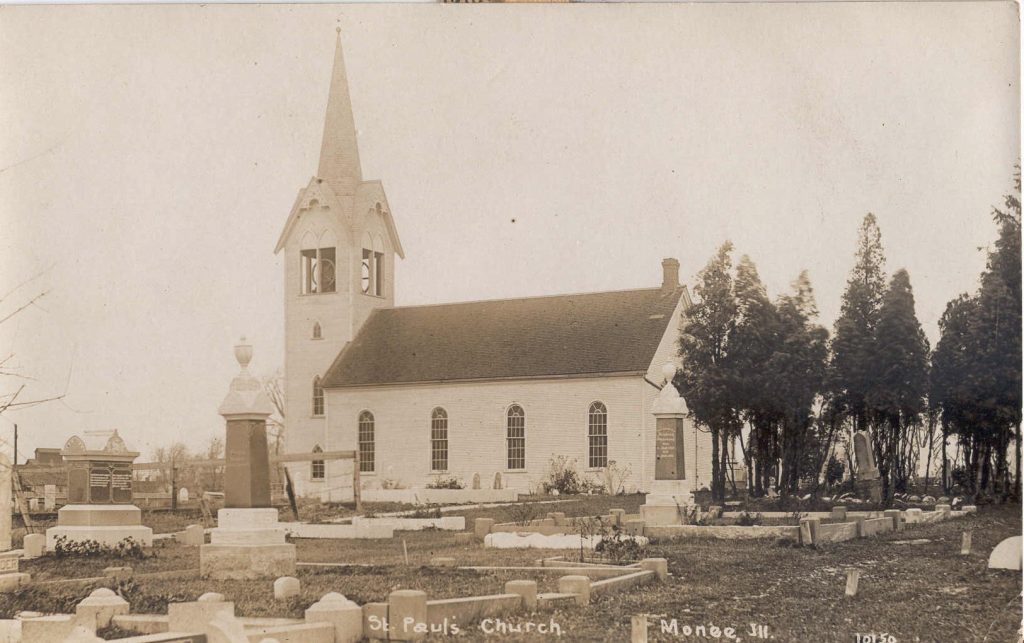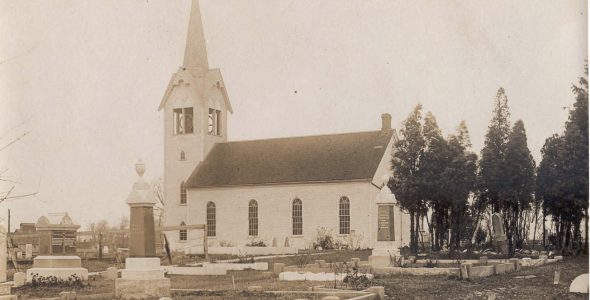History of St Paul’s Cemetery
Excerpt from Reverend Robert Hurst’s “A WALK IN THE CEMETERY”
St. Paul’s has one of the nicest, friendliest cemeteries I know. If you go for a walk there, you can learn a lot about our community, and if you know how to read the stones – which isn’t always easy since many of them are in German – you can discover some amazing and interesting stories.
Some place along the northern border of the cemetery is the continental divide. I believe rain which falls north of Margaret St. and east of Middlepoint follows a series of streams and underground water ways which ultimately drain into Lake Michigan. From Lake Michigan, the water travels through the Great Lakes down the St. Lawrence emptying into the Atlantic Ocean. Rain which falls west of Middlepoint and south of Margaret St. flows out of the village down to the Kankakee River, which joins the Illinois and then the Mississippi until it finally reaches the Gulf of Mexico. Sometimes I like to imagine that the cemetery’s location has some deep and mysterious significance, a kind of secret geographical meaning that James Michener would mold into an epic novel. Monee.
I have sometimes stood in the northwest corner of the cemetery and wondered why the Herbert family chose that site as a place to bury their dead. Augustus Herbert was the founder of Monee, and in 1852, eight years before he deeded what is now the Memorial Garden to the Church, he buried one of his children, George, in the northwest corner of the property. In Europe, the custom was to use the church yard as a burial ground. So in choosing that site for the burial of his son, August Herbert had already chosen the site of the new church, six years before the congregation was ever gathered. Perhaps Augustus was already envisioning a nice little white frame church with a cemetery when he buried little George. But why that place? Of all the land that he owned, what inspired August Herbert to choose that piece of ground to bury his child? The northern section of the cemetery is the highest piece of ground on the south side of the village. The gentle southward slope of the land gives the impression of sunshine and warmth, especially on winter afternoons. At some deep inner level, we are comforted by the sun’s power to overcome the cold and night in the same way we look forward to the light of God’s love to overcome the powers of darkness and death. The sun shining on the graves of our loved ones is symbolic of our faith that they are in God’s tender care.
As I walk through the cemetery I stop to read the stones and guess at the stories which lay hidden in the names written on the markers. For instance, there is the tragic story of the Henry and Johanna Pauling family. Henry and Johanna had four children: Gertrude born in 1874, Arthur born in 1876, Betty born in 1878 and Ella born in the fall of 1880. On March 2nd of 1881, Gertrude, Walthur and Betty all died. When Beth and I first discovered the stone, we were curious about how all three children could have died on the same day. Was it an accident? A fire? Maybe even a murder. When we discovered the answer to this riddle it helped give perspective to our understanding of life in early Monee.
The angel of death which visited the Pauling home on March 2nd of 1881 was named cholera, a dread disease affecting the intestinal system, usually transmitted by contaminated water or milk. There were many epidemics which came to Monee in those early years: typhoid, diphtheria, the great worldwide influenza epidemic of 1918. Florence Becker still remembers the great sadness when four of her little girl friends in her fourth grade Sunday School class died of diphtheria. The threat of communicable disease was a matter of great fear and sometimes terror in the midst of an epidemic. Maude Ruder’s description of her brother William Deutsche’s funeral during the influenza epidemic of 1918 has always fascinated me. It has been estimated that worldwide over 20 million people died of influenza in 1918. People were so afraid of contagion that William’s casket was propped up in the front window of the Deutsche home, so friends and neighbors could file by on the outside to see him. And when William’s body was brought to the cemetery, Rev. Gaebe met the family at the graveside in the southern section of the field, while friends and neighbors looked on from a distance, remaining on the side walk along Margaret Street.
In an age of childhood inoculations, hospitals and antibiotics, it is hard to imagine the helplessness and terror of Henry and Johanna Pauling in the early morning hours of that March 2nd over 100 years ago. Three of their four children were sick. Very sick. The baby Ella was still breast feeding and had not contracted the disease. Cholera caused massive inflammation of the lining of the stomach and intestines. The children had not been able to keep anything down for days and their body fluids were depleting rapidly. Gertrude and Betty died in the night, and for fear of the disease spreading, their bodies had to be buried in the morning. Torn between her concern for Walthur who had survived the night and her desire to say farewell as Gertrude and Betty were lowered into their graves, Johanna went to the cemetery. By the time she returned home, Walthur had died.
Can you imagine the utter grief and hopelessness…losing three children in one day? Probably the only thing which kept Johanna sane was her need to care for the baby who was left. But then even little Ella died on January 16th of 1883, less than two years later. I think it is a real tribute to the faith and courage of Henry and Johanna that two years later in April of 1885 they had another baby, a boy named Edmund, who fortunately survived until 1954. I think people were closer to the church then, because they were also closer to death. For Henry and Johanna the Easter Story was not something that happened a long time ago, but rather a promise that they would one day hold in their arms again Gertrude, Walthur, Betty and Ella.
As I walk directly south from the Pauling stone, the most prominent landmark of the cemetery looms before me – the Kuersten stone. A testimony to the wealth and vanity of four brothers: Henry, Charles, George, and August. The Kuersten monument, erected in 1904, is over thirty feet tall. They were successful farmers, buying and selling grain, trading heavily in real estate. An older member of our community described Charles Kuersten as very tight with his money and very wealthy. “Charles Kuersten owned half of Monee township,” he told me.
But even in that shadow of vanity and wealth I find tragedy. Lorenz and Tillie Kuersten, son and daughter-in-law of August, were a young married couple in January of 1919. Lorenz died on January 19th, and Tillie died on January 20th. They were only 24 and 26 years of age, and were carried off by the same epidemic of influenza which had stricken William Deutsche in November. In the southwest corner of the Kuersten lot are the graves of two young men, Oscar Kuersten, son of George Kuersten, and Fred Schmidke, his friend. Oscar was only 22 and Fred was 24; they were working together operating a steam powered threshing machine on a neighbor’s farm early in the morning of July 30th of 1914. The two friends had started the boiler and were preparing for a day’s work. At 7 a.m. Fred and Oscar were just attaching the belt to the drive wheel, when the boiler blew up. Metal fragments were scattered in all directions. They found Fred Schmidke’s nearly decapitated body about fifty feet from the site of the blast, and poor Oscar Kuersten was found dead in an orchard almost 200 feet from the place where the engine had stood. Since Fred and Oscar had been such good friends, and the Schmidkes were a poor family, it was decided that the two boys should be buried side by side in the Kuersten lot.
As I walk around the Kuersten stone, I discover another mystery which leads to perhaps the saddest story. Three of the brothers, Henry, George and August, all have small stones to mark their individual graves and the graves of their wives and children. But there is no marker for Charles’ grave. Curious, I contacted a Kuersten relative who insists that Charles is buried there, but no one ever placed a marker on his grave. You see Charles was probably the richest and stingiest of the four brothers, and as the years went by everyone came to dislike Charles. Charles’ wife Marie died before Charles, and he placed a marker on her grave. But when Charles died, there was no one who was willing to arrange for a marker for his grave because he had alienated everyone. He reminds me of the rich fool in the gospel of Luke, who fills his barns to overflowing, but who cannot give an account when God demands a reckoning.
I know today some of the Kuersten relatives are embarrassed by their forbearers’ ostentation, but I kind of like that noble obelisk. It’s like an anchor in the middle of that cemetery. After all, how many small town cemeteries can boast of a monument thirty feet tall? Worthy of the Pharaohs, and a reminder that hoarded wealth cannot buy a friend to place a marker on your grave once God has called you home.
As I leave the Kuersten monument behind, walking east, the stone cross marking the Gaebe graves catches my eye. There are four graves on the Gaebe lot. Pastor A.B. Gaebe, 18861970, Talitha Gaebe, 1890-1931, Pastor W. Schuessler, February 23, 1859-0ctober 14, 1931, and Louise Hummel Schuessler, March 15, 1863March 14, 1926. Hidden in these names and dates is a story of courage, sadness and love. Pastor and Mrs. Schuessler were Talitha Gaebe’s parents. Pastor Schuessler had grown up in Germany, and as a young, newly ordained minister had accepted a call to come to America and serve a small German congregation in Southern Illinois. In those days there was no pension program for ministers, so when a pastor became too old or sick to continue in the pulpit, he was forced to seek shelter with his children. So the Schuesslers came to Monee to live with their daughter, son-in-law, and granddaughters, Gertrude and Cordelia. Rev. Schuessler took long walks in the village, read his Bible and prayed. Mrs. Schuessler had a small pump organ in a walk-in closet off her bedroom, and helped Mrs. Gaebe look after the girls.


